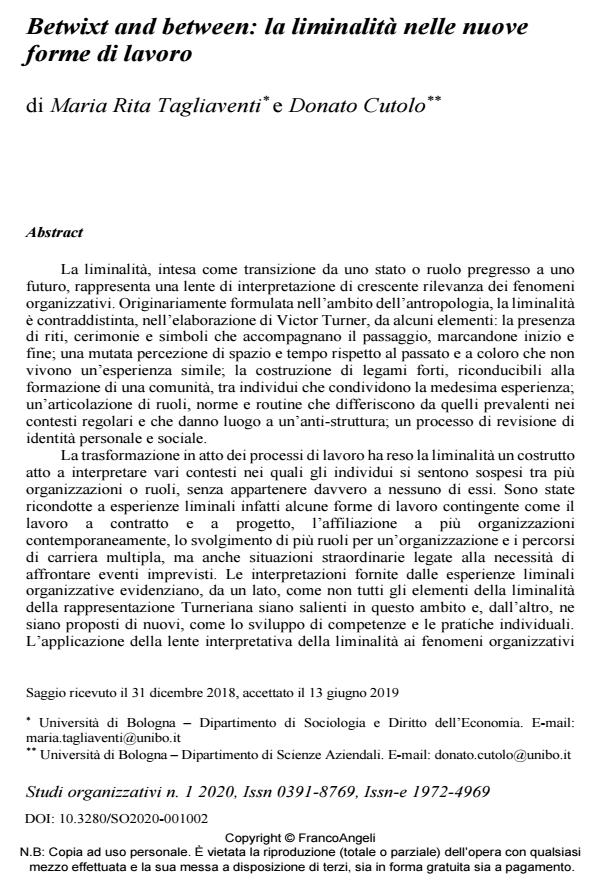Betwixt and between: la liminalità nelle nuove forme di lavoro
Titolo Rivista STUDI ORGANIZZATIVI
Autori/Curatori Maria Rita Tagliaventi, Donato Cutolo
Anno di pubblicazione 2020 Fascicolo 2020/1
Lingua Italiano Numero pagine 29 P. 38-66 Dimensione file 403 KB
DOI 10.3280/SO2020-001002
Il DOI è il codice a barre della proprietà intellettuale: per saperne di più
clicca qui
Qui sotto puoi vedere in anteprima la prima pagina di questo articolo.
Se questo articolo ti interessa, lo puoi acquistare (e scaricare in formato pdf) seguendo le facili indicazioni per acquistare il download credit. Acquista Download Credits per scaricare questo Articolo in formato PDF

FrancoAngeli è membro della Publishers International Linking Association, Inc (PILA)associazione indipendente e non profit per facilitare (attraverso i servizi tecnologici implementati da CrossRef.org) l’accesso degli studiosi ai contenuti digitali nelle pubblicazioni professionali e scientifiche
La liminalità, intesa come transizione da uno stato o ruolo pregresso a uno futuro, rappresenta una lente di interpretazione di crescente rilevanza dei fenomeni organizzativi. Originariamente formulata nell’ambito dell’antropologia, la liminalità è contraddistinta, nell’elaborazione di Victor Turner, da alcuni elementi: la presenza di riti, cerimonie e simboli che accompagnano il passaggio, marcandone inizio e fine; una mutata percezione di spazio e tempo rispetto al passato e a coloro che non vivono un’esperienza simile; la costruzione di legami forti, riconducibili alla formazione di una comunità, tra individui che condividono la medesima esperienza; un’articolazione di ruoli, norme e routine che differiscono da quelli prevalenti nei contesti regolari e che danno luogo a un’anti-struttura; un processo di revisione di identità personale e sociale. La trasformazione in atto dei processi di lavoro ha reso la liminalità un costrutto atto a interpretare vari contesti nei quali gli individui si sentono sospesi tra più organizzazioni o ruoli, senza appartenere davvero a nessuno di essi. Sono state ricondotte a esperienze liminali infatti alcune forme di lavoro contingente come il lavoro a contratto e a progetto, l’affiliazione a più organizzazioni contemporaneamente, lo svolgimento di più ruoli per un’organizzazione e i percorsi di carriera multipla, ma anche situazioni straordinarie legate alla necessità di affrontare eventi imprevisti. Le interpretazioni fornite dalle esperienze liminali organizzative evidenziano, da un lato, come non tutti gli elementi della liminalità della rappresentazione Turneriana siano salienti in questo ambito e, dall’altro, ne siano proposti di nuovi, come lo sviluppo di competenze e le pratiche individuali. L’applicazione della lente interpretativa della liminalità ai fenomeni organizzativi segna pertanto una marcata differenza rispetto alla riflessione antropologica che può comportare un arricchimento del costrutto, ma anche il rischio potenziale di un suo indebolimento per la sovrapposizione con altri costrutti. Nell’equilibrio tra aderenza all’elaborazione originale, soprattutto a quel "sentirsi tra e in mezzo" che è la natura della transizione, e spunti innovativi risiede il potenziale della liminalità di affermarsi come costrutto in grado di agevolare la comprensione di processi di lavoro contemporanei.
Parole chiave:Liminalità, processo di lavoro, identity work, lavoro temporaneo, consulenza, apprendimento, pratica.
- Posizionamenti liminali tra autonomia e dipendenza. Il caso del settore bancario e assicurativo Andrea Bottalico, Annalisa Murgia, in STUDI ORGANIZZATIVI 2/2023 pp.35
DOI: 10.3280/SO2022-002002
Maria Rita Tagliaventi, Donato Cutolo, Betwixt and between: la liminalità nelle nuove forme di lavoro in "STUDI ORGANIZZATIVI " 1/2020, pp 38-66, DOI: 10.3280/SO2020-001002